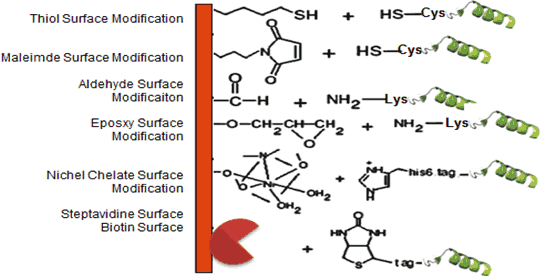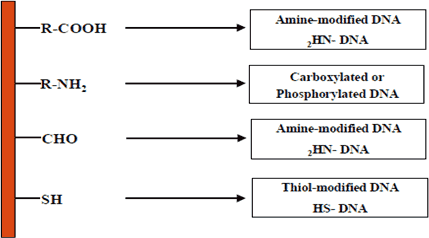Service Portfolios
- Antibody on Agarose
- Small molecule on Agarose
- Oligonucleotide on glass slides
- Oligonucleotide on Luminex Beads
- Oligonucleotide on magnetic Beads
- Oligonucleotides-nanoparticle conjugates
- Peptide on glass slides Peptide on nicrocellulose membrane
- Peptide on ELISA Plates
Can’t find the type of service you need? Don’t worry. We provide numerous bioconjugation services that extend beyond the described service portfolio. Contact us with your detailed project descriptions. In most cases, we can accommodate your bioconjugation needs!
Application
- Drug delivery systems
- Enzyme-Linked Immunosorbent Assays (ELISA)
- Diagnostic assays
- Antibiotic production
- Medical therapeutic
- Nonmedical applications for environmental safety
- Purification of protein
- Extraction of biomolecules using magnetic particles
- Heavy metal removal
- Production of Biosensors
- Production of biodiesel
- Life detection and planetary exploration
Standard Biomolecule Conjugation Service: BIOCON40000
This service is for conjugating biopolymer onto solid supports using a heterobifunctional cross-linker.
Price:
Price varies based on the project specifications. The price list is for reference only. Our service includes materials and labor for conjugation only! Price does not include the cost of biopolymer synthesis and, if deemed necessary, biopolymer modification to introduce additional functional groups, extra linkers and/or spacers. Please contact us for a quote.
Chemistry:
Coupling of preactivated small molecules and biomolecules with chemical reactive groups such as amine, thiol, carboxylate, hydroxyl, aldehyde and ketone, active hydrogen, photo-chemical and cycloaddition reactions, zero-length cross-linking, homobifunctional, heterobifunctional, or multifunctional cross-linking chemistries, denrdimer and dendrons and cleavable regent systems.
Some commonly used cross-linking reagents include:
- Glutaraldehyde - links carrier molecules to N-terminus of peptide
- Carbodiimide (EDC) - attaches carrier to C-terminus of peptide
- Succinimide esters (e.g. MBS, SMCC) - binds free amino group and Cys residues
- Benzidine (BDB) - links to Tyr residues
- Periodate - attaches to carbohydrate groups
- Bioconjugate chemistry may occur through the C- and N-terminals of each polypeptide chain, the carboxylate groups of aspartic and glutamic acids, the ϵ-amine of lysine, the guanidino group of arginine, the sulfhydryl group of cysteine, the phenolate ring of tyrosine, the indole ring of tryptophan, the thioether of methionine and the imidazole ring of histidine.
Service Specification:
After standard desalting or purification, a small percent of heterogeneous products containing single or multi-site conjugate per molecule may exist.
Material:
- Solid Supports
- glass, plates, nitrocellulose membranes, polystyrene, dextran gels, resins, nanogold,
nanosphere, nanocrystal, microsphere, magnetic or luminex beads and qDot.
- Biopolymers
- Protein: Enzyme, antibodies, antigens, cell adhesion molecules
- Peptides: Synthetic polypeptides
- Saccharides: Sugars, oligosaccharides and polysaccharides
- Lipids: Fatty acids, phospholipids, glycolipids and any fat-like substances.
- Ligands: Hormone receptors, cell surface receptors, avidin and biotin, small molecules
- Nucleic acids and nucleotides: DNA, RNA, BNA and other base analogs, nucleic acid analogs and genomic DNA
- Others: Conjugated or mixtures of any the above
Procedure:
All custom synthesis of biomolecule and bioconjugation services are manufactured under strict quality control processes. Bio-Synthesis is committed to Total Quality Management (TQM) to assure customers' complete satisfaction. After immobilization of the biomolecules, a stringent wash and blocking of unreacted sites. Assay or determination of labeling efficiency can be determined for an additional fee.
Bio-Synthesis assists customers introducing functional group or modifying their existing biopolymers such as native protein, oligos peptides or commercially available synthetic compounds to be ready for conjugation with other biopolymers.
Sample Requirements
Non-commercial small molecule supplied by customer
User-supplied, non-commercial small or macromolecule should be sufficiently pure (≥95% pure). Please provide the QC data (typically HPLC, MS, ESI or NMR data etc.) and MSDS (if any) along with your compound. We can assist with the purification and acquisition of analytical data. These compounds must contain functional groups that can be targeted for cross-linking including carboxylate groups, primary amine groups, aldehyde/keto residues, hydroxyl, hydrazine, hydrazide, aminoxy, saccharide/glycan groups or thiol reactive functional group(s). Coupling also can be nonselective using a photoreactive phenyl azide cross-linker. If necessary, we can also assist with the creation and activation of specific functionalities. Any sample supplied by the client requires a quality check by our analytical team to ensure sample quality prior conjugation.
Commercially available small molecules
Commercially available small molecules can be supplied by customers or ordered through Bio-Synthesis. Common small molecules such as common fluorescent dyes, biotin-NHS and other hetero-bifunctional cross-linkers are available at Bio-Synthesis. For in stock compounds, Bio-Synthesis will charge customers only the amount needed for conjugation. If the small molecules are to be purchased separately, the cost of acquiring this material will be added to the invoice along with a $50 administration charge per order.
Non-commercially available small molecules
We can custom synthesize small molecules in house. A quotation will be prepared for such syntheses.
Oligonucleotide, oligomimetics and custom gene or genomic DNA
DNA, RNA and nucleic acid analogs such as BNA and other base analogs can be synthesized in-house at Bio-Synthesis, followed by subsequent conjugation through amino, thiol, aldehyde, azide, carobxyl or 5'-phosphate modification. Oligos supplied by the customer should be HPLC or gel purified (>90% pure). Please provide the QC data needed for purity assessment. Extra charges may apply for analyzing the starting materials at Bio-Synthesis.
Peptides, peptidomimetics, and expressed protein
Peptides and proteins can be synthesized or expressed in-house at Bio-Synthesis. We label or conjugate peptides through N-terminal, C-terminal or internal side chain of an amino acids. Peptides supplied by the customer should be HPLC purified (>90% pure) and should a single modification site. We can make any standard peptides with functional groups incorporated through peptide synthesis. Please provide the peptide sequence of the desired peptide on the order form.
Antibodies
Commercial antibodies can be supplied by customers or ordered through Bio-Synthesis with an additional fee plus cost of antibody. Non-commercial biopolymers supplied by customers should be affinity purified. Please provide gel electrophoresis data along with your antibody. Bio-Synthesis also assists customers with antibody production, purification, modification and fragmentation prior to any cross-linking reaction.
Functional target modification services
We offer post-synthetic modification of ligands to be immobilized on various solid supports, allowing the immobilization process to occur selectively in the presence of common functional groups, including amines, thiols, carboxylic acids and alcohols. Bio-Synthesis offers functional group modification and derivatization:
- Amino acid, peptides and protein modification
- Modification of sugars, polysaccharides and glycoconjugates
- Modification of nucleic acids and oligonucleotides
- Creating Specific functionalities such as sulfhydryl, carboxylate, primary amine, aldehyde/ketone, hydrazine or hydrazide, saccharide and glycan groups
- Blocking functional group such as amine, sulfhydryl, aldehyde or carboxylate groups
See more information on Biomolecule Modification
Chemistry of Reactive Group used
Every chemical modification or conjugation process involves the reaction of one functional group with another, resulting in the formation of a covalent bond. The creation of bioconjugate reagents with spontaneously reactive, or selectively reactive functional groups, forms the basis for simple and reproducible cross-linking or tagging of target molecules. Our well-trained chemists assist clients from starting project scope collections to designing and determining appropriate homobifunctional or heterobifunctional cross-linking chemistries. We have delivered thousands of custom conjugated biopolymers and are fully capable of meeting the ever-increasing bioconjugation needs in biological and drug discovery research. Hundreds of reaction systems have applied in our organic laboratories.
- Amine Reaction: NHS ester, imidoester, hydroxymethyl phosphine, guanidination of amine, fluorophenyl esters, carbodiimides, anhydrides, arylating agents, carbonates, aldehydes and glyoxals
- Thiol Reactions: Maleimide, Haloacetyl, Pyridyldisulfide, Vinyl sulfone, Thiol-disulfide exchange
- Carboxylate reactions: Carbodiimides
- Hydroxyl Reactions: Isocyanates, enzymatic oxidation, Carbonyldiimidazole
- Aldehyde and Ketone Reaction: Hydrazine derivative, Schiff Base formation, reductive amination
- Active Hydrogen Reaction: Iodination reaction
- Photo-chemical Reactions: Psoralen compounds, aryl azides and halogenated aryl azides, bensophenones, anthraquinones
- Cycloaddition Reaction: Chemoselective ligation such as Click chemistry, Diels-Alder reaction
General Route for Immobilization

Cross-linking Strategies for Immobilization of Protein

Cross-linking strategies for Immobilization of oligonucleotides: DNA, RNA, BNA and other base analogs

Reference/Citing:
- Upadhyay, A. et al.: Immunological Response to Peptide Nucleic Acid and its Peptide Conjugate Targeted to Transactivation Response (TAR) Region of HIV-1 RNA Genome; Oligonucleotides. 18(4) 2008.
- Olejnik, J. et al.: Photocleavable peptide-DNA conjugates: synthesis and applications to DNA analysis using MALDI-MS; Nucleic Acid Researech. 27 (23) 1999.
- Pai, S. et al.: Proximity ligation assays with peptide conjugate 'burrs' for the sensitive detection of spores; Nucleic Acid Research. 33(18) 2005.
Visit our literature vaults for more references and citings.
Ordering and Submitting Requests for Bioconjugation Services
For us to better understand your customized project, please complete our Bioconjugation Service Questionnaire. The more our chemists understand your project’s needs, the more accurate your provided feedback will be. Providing us with your project’s details enables us to recommend the best reagents to use for your project. The most useful and readily available tools for bioconjugation projects are cross-linking reagents. A large number of cross-linkers, also known as bifunctional reagents, have been developed. There are several ways to classify the cross-linkers, such as the type of reactive group, hydrophobicity or hydrophilicity and the length of the spacer between reactive groups. Other factors to consider are whether the two reactive groups are the same or different (i.e. heterobifunctional or homobifunctional reagents), spacer is cleavable and if reagents are membrane permeable or impermeable. The most accessible and abundant reactive groups in proteins are the ϵ-amino groups of lysine. Therefore, a large number of the most common cross-linkers are amino selective reagents, such as imidoesters, sulfo-N-hydroxysuccinimide esters and N-hydroxysuccinimide esters. Due to the high reactivity of the thiol group with N-ethylmaleimide, iodoacetate and a-halocarbonyl compounds, new cross-linkers have been developed containing maleimide and a-carbonyl moieties. Usually, N-alkylmaleimides are more stable than their N-aryl counterparts.
In addition to the reactive groups on the cross-linkers, a wide variety of connectors and spacer arms have also been developed. The nature and length of the spacer arm play an important role in the functionality. Longer spacer arms are generally more effective when coupling large proteins or those with sterically protected reactive side-chains. Other important considerations are the hydrophobicity, hydrophilicity and the conformational flexibility. Long aliphatic chains generally fold on themselves when in an aqueous environment, making the actual distance spanned by such linker arms less than expected. Instead, spacers containing more rigid structures (for example, aromatic groups or cycloalkanes) should be used. These structures, however, tend to be very hydrophobic which could significantly decrease the solubility of the modified molecules or even modify some of their properties. In such cases, it is recommended to choose a spacer that contains an alkyl ether (PEO) chain. Bio-Synthesis offers several cross-linkers with PEO chains, such as thiol-binding homobifunctional reagents, heterobifunctional bases and their derivatives.
Within 3-5 days upon receiving your project scope, we will provide you an appropriate quotation. An order can be placed with PO (Purchase Order) or major credit cards (  ). Your credit card will be billed under Bio-Synthesis, Inc.
). Your credit card will be billed under Bio-Synthesis, Inc.